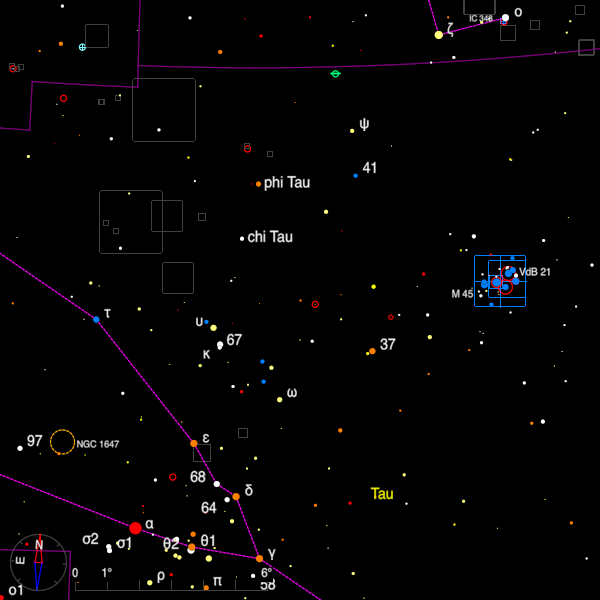January 2022 - Double Star of the Month
phi Tauri (04 20 21.2 +27 21 03) can be found about 10 degrees north of the Hyades. Found by William Herschel, it is an attractive double star for small apertures, offering as it does, a beautiful colour contrast between the two components. The primary is a K1 giant which W. H. Smyth found to be pale red but I noted as golden yellow with a 21-cm mirror in 1968. The companion is blue and the stars are magnitudes 5.0 and 7.4.

I found the position angle (PA) and separation to be 258 degrees and 48".4 in 2015 and whilst this is significantly different to the first measures of this pair, the differences are due entirely to differences in proper motion due to the differing distances to each star; 284 light-years for the primary, and 346 light-years for the secondary.
Just 2 degrees south, and slightly east of phi is chi (04 22 34.9 +25 37 45), another probably optical pair, but with magnitudes of 5.4 and 8.5, it is also well-seen in small telescopes. The stars are separated by 19" in position angle 25 degrees.
The 4.4 magnitude tau (or 30) Canis Majoris (07 18 42.49 -24 57 15.8) is at the centre of the open cluster NGC 2362. Like many stars in this region it is young, hot and very luminous and has a spectral type of 09II.

It attracts the interest of the double star observer because it appears in the catalogue of John Herschel as HJ 3948. The nomenclature applies to companions of 10.2, 11.2 and 8.2 at distances of 8".3, 14".2 and 83".5 respectively and it is of interest to the binocular observer as well as the small aperture telescope.
Tau itself, has 5 components all within 1 arc-second. Quite recently, Dr. Andrei Tokovinin found a magnitude 9.7 star nestling 0".9 away whilst in 1951, the great interferometric observer William Finsen noted another star 0".2 distant. Tau is also a tight triple star with a fainter eclipsing binary, orbiting tau itself as a spectroscopic binary with a period of 154 days.
Bob Argyle - Double Star Section Director